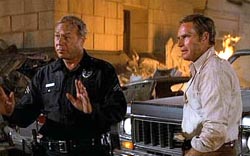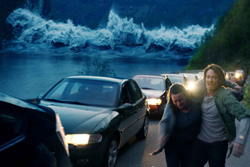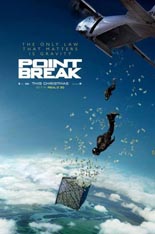
 Look, just because something is old does not make it great. And yet, as the Point Break remake surfed into theaters on Christmas Day 2015, I do not recall running across a single article or review that failed to refer to the 1991 original, which paired Patrick Swayze with Keanu Reeves, as “classic” — noun or adjective. “Classic” is a charged word — one that should be earned rightfully vs. bestowed automatically.
Look, just because something is old does not make it great. And yet, as the Point Break remake surfed into theaters on Christmas Day 2015, I do not recall running across a single article or review that failed to refer to the 1991 original, which paired Patrick Swayze with Keanu Reeves, as “classic” — noun or adjective. “Classic” is a charged word — one that should be earned rightfully vs. bestowed automatically.
Perhaps Swayze’s too-young passing in 2009 is responsible for the revisionist love, because Kathryn Bigelow’s crime flick was neither well-reviewed nor a hit in its July ’91 bow. In fact, its $8 million opening placed it in fourth that weekend, behind James Cameron’s Terminator 2: Judgment Day, John Singleton’s Boyz n the Hood and a reissue of a then-30-year-old cartoon, Disney’s 101 Dalmatians.
So, old? Definitely. Classic? Hardly.
With that out of that way, back to the “new” Point Break …
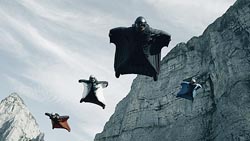 … and wow, does it suck. Seven years after witnessing (if not encouraging) the death of his dumbass bike-riding buddy (Max Thieriot, House at the End of the Street), extreme-sports athlete Johnny Utah (Luke Bracey, The November Man) has reinvented himself as an FBI agent. When a group of rogue extreme-sports enthusiasts use their extreme-sports skills to pull off a series of extreme heists, Utah is the only one who convincingly can go deep, deep, deep, deep undercover. After all, he’s got the extreme-sports know-how, the sleeve tats and, of utmost importance, the looks of what would result from The Fast and the Furious’ Paul Walker impregnating Sons of Anarchy’s Charlie Hunnam.
… and wow, does it suck. Seven years after witnessing (if not encouraging) the death of his dumbass bike-riding buddy (Max Thieriot, House at the End of the Street), extreme-sports athlete Johnny Utah (Luke Bracey, The November Man) has reinvented himself as an FBI agent. When a group of rogue extreme-sports enthusiasts use their extreme-sports skills to pull off a series of extreme heists, Utah is the only one who convincingly can go deep, deep, deep, deep undercover. After all, he’s got the extreme-sports know-how, the sleeve tats and, of utmost importance, the looks of what would result from The Fast and the Furious’ Paul Walker impregnating Sons of Anarchy’s Charlie Hunnam.
With the bureau’s blessing and armed with gun and surfboard, Utah takes off to infiltrate the gang, crack the case and bring ’em to justice … extreme justice. (Fun fact: According to one of the film’s posters, justice has no limit. Crime doesn’t, either, according to another. #themoreyouknow) Led by the Zen-ful Bodhi (Deliver Us from Evil’s Edgar Ramírez, too good an actor to endure haircuts as super-silly as he does here), the group operates under a Robin Hood agenda of wealth redistribution: Steal from the rich, make it rain on Third World countries. Bodhi’s crew members have names like Roach, Chowder, Grommet and Samsara, and welcome Utah into their bro-dude family with irony-free lines like, “What’s a motocross rider like you doing on a wave like that?” and “The only law that matters is gravity.”
Yes, Point Break is exactly that point-blank simpleminded, and its stupidity exhausts the viewer. Clearly cribbing more from the likes of Furious 7 than Bigelow’s big Break, it boasts some absolutely amazing stunt sequences that impart if not an adrenaline rush, then a solid contact high. Yet not even the best is worth suffering two hours plus of boneheaded dialogue and an unintentionally hilarious bumped-uglies subplot between Utah and eco-friendly earth child Samsara (Warm Bodies’ Teresa Palmer, suffering the further indignity of having her breasts pushed up to her neck). Invincible director Ericson Core (chosen for his extreme name?) is no Bigelow; while he can shoot leaping, jumping, running, falling and other action verbs all day, the man is forever crippled when it comes to mere walking and talking. —Rod Lott


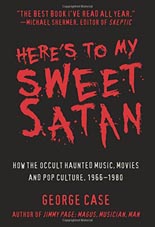
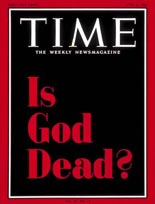
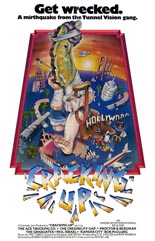
 From 1983, the Jerry Lewis comedy
From 1983, the Jerry Lewis comedy 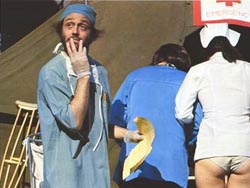

 What Mark Robson built in 1967’s
What Mark Robson built in 1967’s 